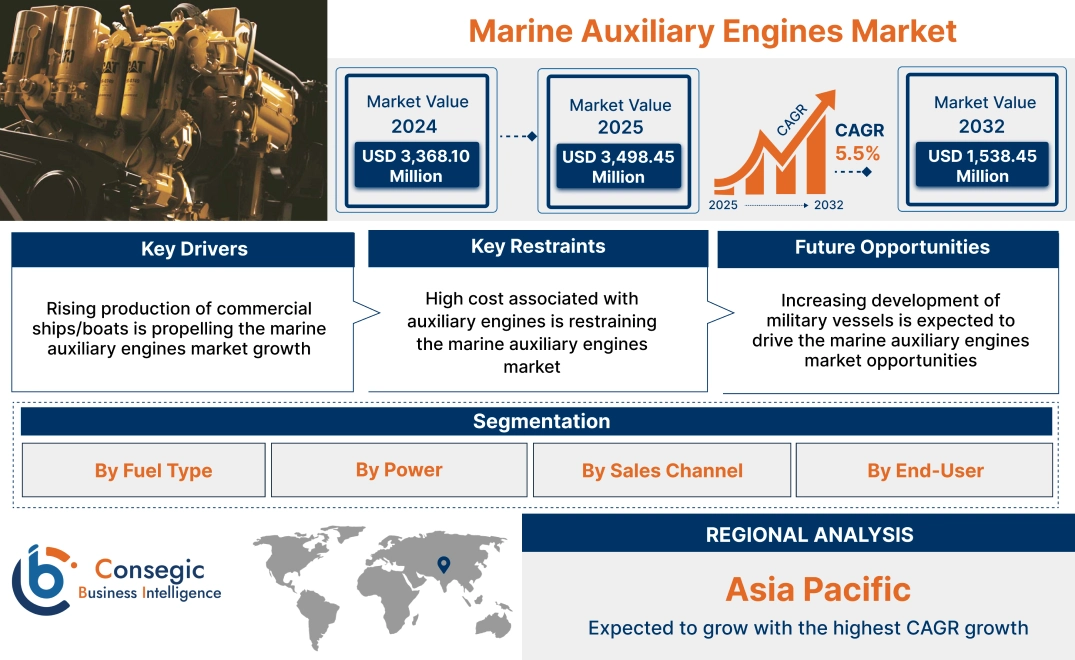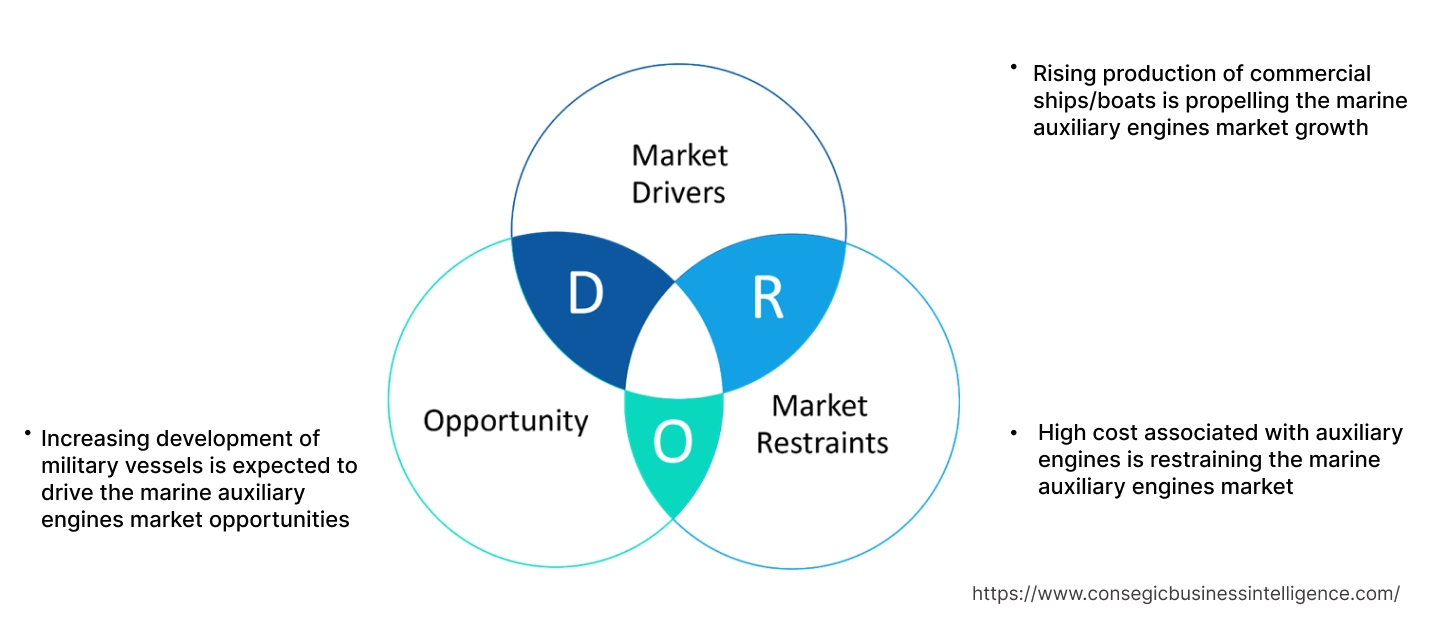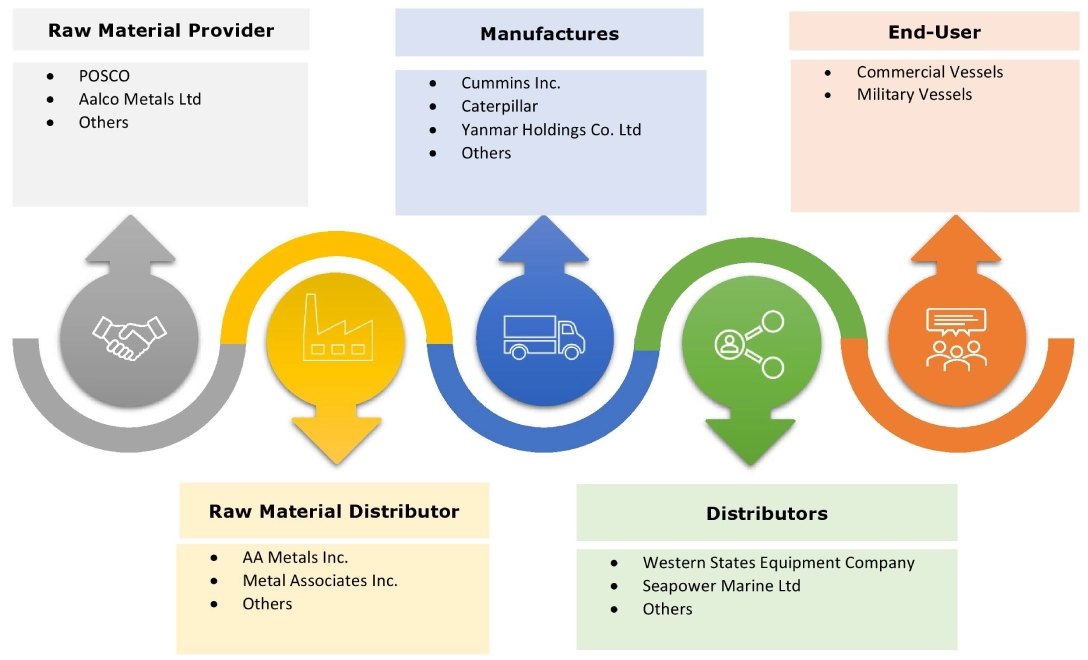- Summary
- Table Of Content
- Methodology
Marine Auxiliary Engines Market Size:
Marine Auxiliary Engines Market size is estimated to reach over USD 5,008.19 Million by 2032 from a value of USD 3,368.10 Million in 2024 and is projected to grow by USD 3,498.45 Million in 2025, growing at a CAGR of 5.5% from 2025 to 2032.
Marine Auxiliary Engines Market Scope & Overview:
Marine auxiliary engines refer to secondary engines that are used on ships and boats to provide power for various on-board operations, aside from the primary propulsion of the vessel. These engines play a crucial role in generating electrical power for powering essential systems such as lighting, air conditioning (HVAC), communication devices, navigation equipment, pumps, and other machinery required for the safe and efficient operation of the vessel. Moreover, the utilization of auxiliary engines in marine vessels ensures that critical systems can continue to operate independently of the main engines, in turn enhancing overall operational reliability.
Key Drivers:
Rising production of commercial ships/boats is propelling the marine auxiliary engines market growth
Auxiliary engines play a crucial role in commercial chips and boats for supporting a wide variety of functions that ensure the safe and efficient operation of the ship or boat. Marine auxiliary engines are primarily used to drive generators that supply electricity to the vessel for lighting, navigation systems, communication equipment, and other electrical requirements. They are often used for powering pumps along with heating systems and air conditioning systems to maintain a comfortable environment for the crew and passengers within a commercial ship. Auxiliary engines also provide an emergency power source for commercial ships and boats in case of a failure of the main propulsion system.
- For instance, in January 2022, American Cruise Lines announced Project Blue, which comprises of a new fleet of commercial ships for the US market. The project involves building of 12 identical sister ships for domestic coastal cruises, among which the first two vessels were launched in 2023.
Therefore, the rising production of commercial ships is driving the adoption of auxiliary engines to provide power for various on-board operations, aside from the primary propulsion of the vessel, in turn proliferating the marine auxiliary engines market size.
Key Restraints:
High cost associated with auxiliary engines is restraining the marine auxiliary engines market
The implementation of auxiliary engines is usually associated with high costs, which is a primary factor restricting the market growth. Moreover, the high upfront costs associated with acquisition of auxiliary engines may cause financial barriers, particularly for smaller marine fleet operators or businesses that are operating on tighter budgets.
For instance, the average cost of marine auxiliary engine ranges from USD 3,000 to USD 8,000 per unit or more, depending on the type and specification of auxiliary engines, which is relatively very high. Therefore, the high cost associated with marine auxiliary engines is hindering the marine auxiliary engines market expansion.
Future Opportunities :
Increasing development of military vessels is expected to drive the marine auxiliary engines market opportunities
Auxiliary engines play a vital role in military vessels for providing essential support for a wide range of operational and logistical functions. Marine auxiliary engines are used to supply electricity for onboard systems, including navigation, communication, surveillance, weapon systems, and lighting. Reliable electrical power is crucial for the effective operation of these systems, particularly during combat or tactical missions. Auxiliary engines are also used as an emergency power supply for marine vessels to ensure that critical systems remain operational in case of failure or damage to primary propulsion engine. Moreover, the use of auxiliary engines in marine vessels offers several benefits including increased operational reliability, flexibility in operations, and improved operational efficiency among others.
- For instance, in September 2024, ThyssenKrupp Marine Systems and NVL signed a cooperation agreement for joint construction of the MEKO A-400 AMD, a ship concept particularly developed to meet the requirements of a German Navy defense frigate. The ship offers enhanced energy supply for future weapon and command systems. The ship also features a new hull that provides more space for installation of missiles along with facilitating a high cruising speed for multi-national task forces.
Hence, as per the analysis, the rising development of military vessels is projected to increase the demand for auxiliary engines, thereby, driving the marine auxiliary engines market opportunities during the forecast period.
Marine Auxiliary Engines Market Segmental Analysis :
By Fuel Type:
Based on fuel type, the market is segmented into diesel, gas, others.
Trends in the fuel type:
- Increasing adoption of diesel fuel due to its several benefits including high energy density, increased availability, and others.
- There is a rising trend towards utilization of liquefied natural gas (LNG) as a cleaner fuel alternative for auxiliary engine, attributing to its lower emissions, fuel flexibility, and eco-friendliness.
The diesel segment accounted for a largest revenue share of 66.72% in the total marine auxiliary engines market share in 2024.
- Diesel has been used as the traditional fuel for marine auxiliary engines and it is widely used across various types of vessels, including cargo ships, tankers, fishing boats, and naval vessels.
- Diesel engines are favoured for auxiliary operations such as power generation, pumping systems, and other essential functions.
- Moreover, diesel offers a range of benefits including high energy density, increased availability, and reliability, which are primary determinants for increasing its utilization in auxiliary engines.
- For instance, Weichai is a marine engine manufacturer that offers WP4CD 66 series and WP6CD 132 series of auxiliary diesel engines in its product offerings.
- According to the marine auxiliary engines market analysis, the rising advancements associated with auxiliary diesel engines for application in marine vessels are driving the marine auxiliary engines market growth.
The gas segment is anticipated to register significant CAGR growth during the forecast period.
- Liquefied natural gas (LNG) is increasingly being utilized as a cleaner fuel alternative for auxiliary engine.
- LNG engines can be deployed in various vessel types, including ferries, container ships, and offshore supply vessels among others.
- Moreover, LNG provides numerous benefits including lower emissions, noise reduction, fuel flexibility, and eco-friendliness.
- For instance, in June 2023, MAN launched its new MAN 35/44DF CD model of auxiliary engine for marine applications. The engine offers fuel flexibility and can utilize both gas as well as biofuels as its fuel source. The engine features compact footprint with high power output.
- Therefore, the increasing innovations related to auxiliary engines with gas as its fuel source are anticipated to boost the marine auxiliary engines market size during the forecast period.
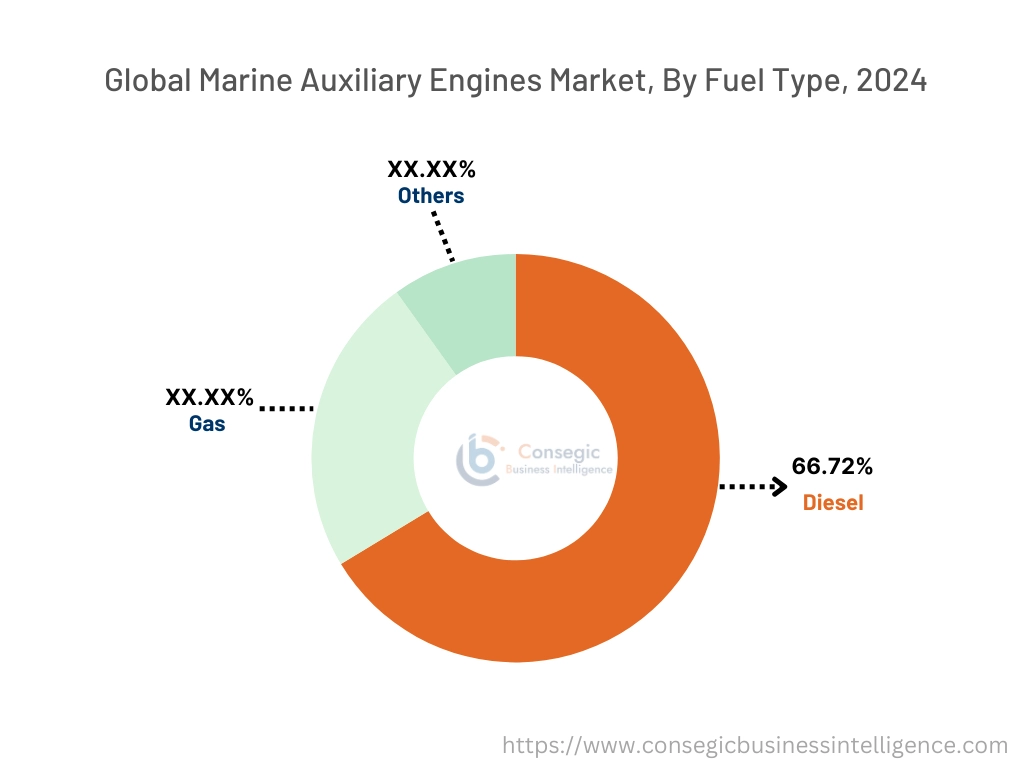
By Power:
Based on power, the market is segmented into up to 500 HP, 500 to 1000 HP, and over 1000 HP.
Trends in the power:
- There is an increasing trend towards adoption of auxiliary engines with power output up to 500 HP in fishing boats, patrol boats, ferries, and smaller commercial vessels.
- Rising adoption of auxiliary engines with power output ranging from 500 to 1000 HP on larger vessels due to its higher load handling capability and enhanced performance
Up to 500 segment accounted for the largest revenue in the overall marine auxiliary engines market share in 2024.
- Auxiliary engines with power output up to 500 HP are often used on smaller marine vessels such as fishing boats, patrol boats, ferries, and smaller commercial vessels.
- Moreover, auxiliary engines with power output up to 500 HP offer a range of benefits including compact design, fuel efficiency, ease of maintenance, and cost-efficiency among others.
- For instance, Deere & Company offers 4045TF285, 6068HF485, 6090HF485 models of auxiliary engines with power output of 99 HP, 251 HP, and 375 HP respectively.
- Therefore, the rising developments associated with auxiliary engines with power output up to 500 HP are driving the marine auxiliary engines market trends.
500 to 1000 HP is anticipated to register a substantial CAGR growth during the forecast period.
- Auxiliary engines with power output ranging from 500 to 1000 HP are primarily used on larger vessels, including medium-sized cargo ships, tankers, offshore support vessels, and naval ships among others.
- Auxiliary engines with power output ranging from 500 to 1000 HP can handle higher loads and provide improved performance, making them ideal for more demanding marine applications.
- For instance, Cummins Inc. offers QSK19 and KTA19 models of auxiliary engines in its product portfolio with power output ranging from 500 to 1000 HP for marine applications.
- Thus, increasing advancements associated with auxiliary engines with power output from 500 to 1000 HP are projected to boost the market during the forecast period.
By Sales Channel:
Based on sales channel, the market is segmented into direct sales and distributor sales.
Trends in the sales channel:
- Factors including the availability of excellent support and warranty, higher product quality, and reliable shipping and return policies are key prospects driving the segmental growth of direct sales channel.
- Factors such as higher accessibility to a variety of products, higher flexibility, and expanded reach are major determinants for driving the distributor sales channel segment.
Direct sales channel segment accounted for a significant revenue in the overall auxiliary engine technology market share in 2024.
- In direct sales channel, auxiliary engines are sold directly to customers through numerous physical outlets including company outlets among others.
- Moreover, the direct sales channel also consists of online mode, wherein the manufacturers sell auxiliary engines through its own company websites.
- Additionally, purchasing auxiliary engines from direct sales channel offers numerous benefits including faster response time, higher product quality, higher return on investments, competitive pricing, and others which are key determinants for increasing the purchase of auxiliary engines from direct sales channel.
- For instance, Caterpillar is an auxiliary engine manufacturer that offers a broad range of auxiliary engines for direct purchase through the company website.
- Therefore, increasing availability of auxiliary engines in direct sales channels are driving the market.
Distributor sales segment is anticipated to register a substantial CAGR growth during the forecast period.
- The distributor sales channel involves indirect distribution of auxiliary engines, wherein the auxiliary engines are purchased from several regional distributors operating multiple regions worldwide.
- Moreover, distributor sales channel provides several benefits including increased market reach, reduced capital expenditure, increased cost efficiency, and others. The above benefits of distributor sales channel are further increasing its utilization for purchase of auxiliary engines.
- For instance, Western States Equipment Company, Seapower Marine Ltd, and others are few of the distributors of auxiliary engines.
- Hence, the increasing availability of auxiliary engines in distributor sales channel is anticipated to boost the market during the forecast period.
By End-User:
Based on the end-use, the market is segmented into commercial vessels and military vessels.
Trends in the end-user:
- Factors including rising maritime trade, growing popularity of cruise ships, and increasing commercial fleet are key trends propelling the commercial vessels segment.
- Rising technological advancements in naval defense systems and increasing government investments in navy defense platform are primary trends driving the military vessels segment.
Commercial vessels segment accounted for the largest revenue share in the total market in 2024.
- This dominance is attributed to the rising adoption of auxiliary engines in commercial ships and boats for supporting a wide variety of functions that ensure the safe and efficient operation of the commercial vessels.
- Auxiliary engines are primarily used to supply electricity to the commercial vessels for lighting, navigation systems, communication equipment, and other electrical requirements.
- For instance, Kenya Shipyard Limited partnered with Damen Shipyards, a Dutch shipbuilding company, for the development of the MV Uhuru II, which is a commercial marine vessel built at Kisumu port in Kenya. The cargo ship entered into service on Lake Victoria in 2023.
- According to the analysis, the rising production of commercial vessels is driving the marine auxiliary engines market trends.
Military vessels segment is anticipated to register a significant CAGR during the forecast period.
- Auxiliary engines play an essential role in military vessels for providing essential support for a wide range of operational and logistical functions.
- Auxiliary engines used to supply electricity for onboard systems, including navigation, communication, surveillance, weapon systems, and lighting.
- Moreover, the integration of auxiliary engines in marine vessels offers several benefits including increased operational reliability, flexibility in operations, and improved operational efficiency among others.
- For instance, the South African Department of Defence invested USD 225.7 million for the development of three ships, among which, the first of three multi-mission inshore marine vessels were delivered to the South African Navy in 2022.
- Therefore, the increasing development of military vessels is expected to drive the demand for auxiliary engines, in turn propelling the market during the forecast period.
Regional Analysis:
The regions covered are North America, Europe, Asia Pacific, the Middle East and Africa, and Latin America.
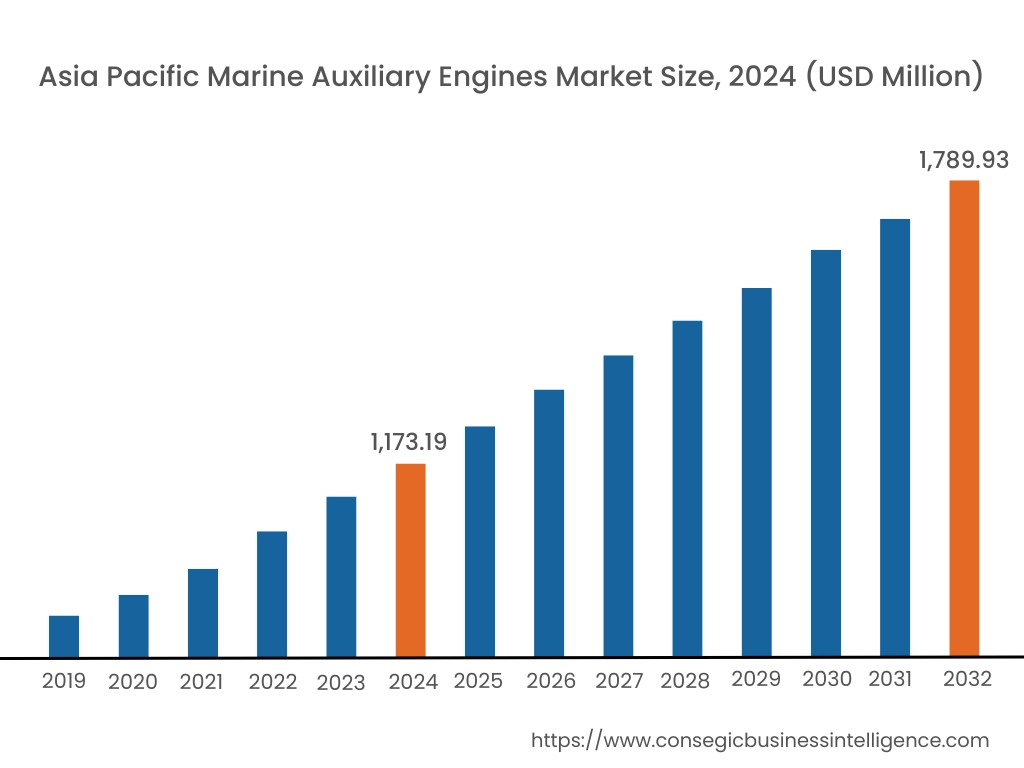
Asia Pacific region was valued at USD 1,173.19 Million in 2024. Moreover, it is projected to grow by USD 1,221.24 Million in 2025 and reach over USD 1,789.93 Million by 2032. Out of this, China accounted for the maximum revenue share of 35.4%. As per the marine auxiliary engines market analysis, the adoption of auxiliary engines in the Asia-Pacific region is primarily driven by the increasing shipbuilding projects and rising investments in military vessels among others. Additionally, the rising production of marine vessels is further accelerating the marine auxiliary engines market expansion.
- For instance, in February 2022, Mitsubishi Shipbuilding partnered with TotalEnergies for the construction of a liquefied CO2 marine carrier in Japan. The above factors are driving the adoption of auxiliary engines, in turn propelling the market in the Asia-Pacific region.
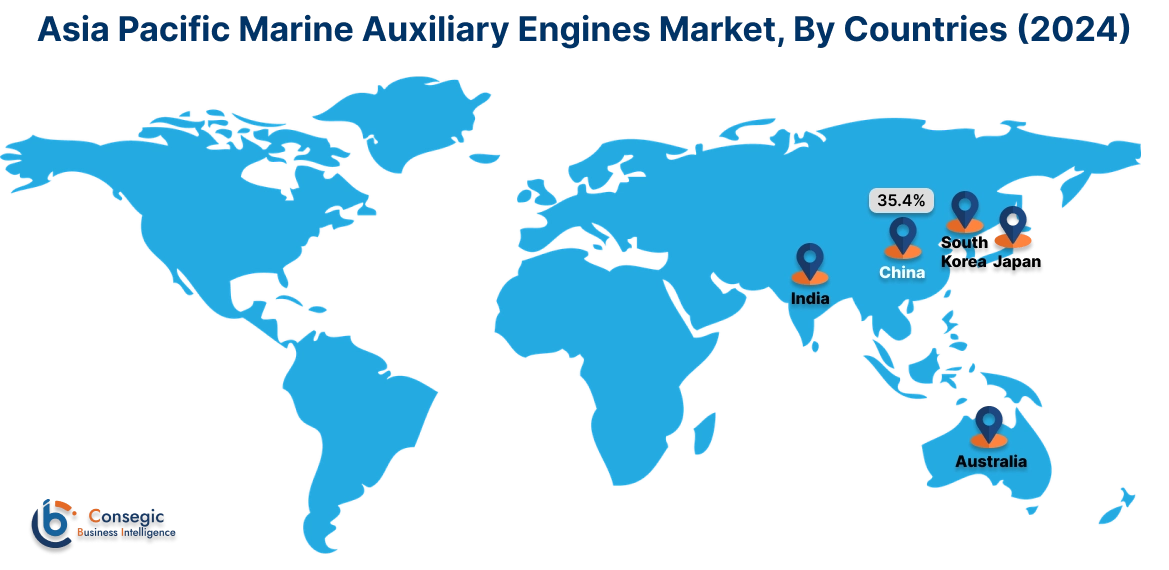
North America is estimated to reach over USD 1,252.55 Million by 2032 from a value of USD 854.81 Million in 2024 and is projected to grow by USD 886.82 Million in 2025.
In North America, the growth of marine auxiliary engines industry is driven by the growing popularity of cruise ships and rising investments in military vessels among others. Similarly, the rising development of commercial ships are contributing to the marine auxiliary engines market demand.
Additionally, the regional analysis depicts that rising production of military and commercial vessels are driving the marine auxiliary engines market demand in Europe. Furthermore, as per the market analysis, the market demand in Latin America, Middle East, and African regions is expected to grow at a considerable rate due to factors such as growing marine industry and increasing maritime trade among others.
Top Key Players and Market Share Insights:
The global marine auxiliary engines market is highly competitive with major players providing services to the national and international markets. Key players are adopting several strategies in research and development (R&D), product innovation, and end-user launches to hold a strong position in the marine auxiliary engines market. Key players in the marine auxiliary engines industry include-
- Cummins Inc. (US)
- Caterpillar (US)
- Hyundai Heavy Industries Co. Ltd (South Korea)
- Kirloskar Oil Engines Ltd. (India)
- Perkins Engines Company Limited (United Kingdom)
- Yanmar Holdings Co. Ltd (Japan)
- Wabtec Corporation (US)
- MAN (Germany)
- Deere & Company (US)
- Mitsubishi Heavy Industries Group (Japan)
Recent Industry Developments :
Product Launch:
- In September 2023, Perkins Engines Company Limited launched its new E44 and E70B models of auxiliary engines for utilization in marine applications involving inland waterways, governmental, fishing, and ferry services.
- In June 2023, MAN launched its new MAN 35/44DF CD model of auxiliary engine for marine applications. The engine offers fuel flexibility and can utilize both gas and biofuels as its fuel source. The auxiliary engine features compact footprint with high power output.
Marine Auxiliary Engines Market Report Insights :
| Report Attributes | Report Details |
| Study Timeline | 2019-2032 |
| Market Size in 2032 | USD 5,008.19 Million |
| CAGR (2025-2032) | 5.5% |
| By Fuel Type |
|
| By Power |
|
| By Sales Channel |
|
| By End-User |
|
| By Region |
|
| Key Players |
|
| North America | U.S. Canada Mexico |
| Europe | U.K. Germany France Spain Italy Russia Benelux Rest of Europe |
| APAC | China South Korea Japan India Australia ASEAN Rest of Asia-Pacific |
| Middle East and Africa | GCC Turkey South Africa Rest of MEA |
| LATAM | Brazil Argentina Chile Rest of LATAM |
| Report Coverage |
|
Key Questions Answered in the Report
How big is the marine auxiliary engines market? +
The marine auxiliary engines market was valued at USD 3,368.10 Million in 2024 and is projected to grow to USD 5,008.19 Million by 2032.
Which is the fastest-growing region in the marine auxiliary engines market? +
Asia-Pacific is the region experiencing the most rapid growth in the marine auxiliary engines market.
What specific segmentation details are covered in the marine auxiliary engines report? +
The marine auxiliary engines report includes specific segmentation details for fuel type, power, sales channel, end-user, and region.
Who are the major players in the marine auxiliary engines market? +
The key participants in the marine auxiliary engines market are Cummins Inc. (US), Caterpillar (US), Yanmar Holdings Co. Ltd (Japan), Wabtec Corporation (US), MAN (Germany), Deere & Company (US), Mitsubishi Heavy Industries Group (Japan), Hyundai Heavy Industries Co. Ltd (South Korea), Kirloskar Oil Engines Ltd. (India), and Perkins Engines Company Limited (United Kingdom).
